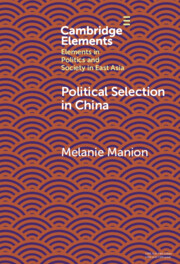Refine search
Actions for selected content:
39 results
9 - Telework and Digital Surveillance
-
-
- Book:
- Remote Work and Labor Institutions
- Published online:
- 12 December 2025
- Print publication:
- 22 January 2026, pp 148-161
-
- Chapter
-
- You have access
- Open access
- HTML
- Export citation
1 - The Hidden Political Roles of Firms in China
-
- Book:
- Politicizing Business
- Published online:
- 29 September 2025
- Print publication:
- 25 September 2025, pp 1-36
-
- Chapter
- Export citation
2 - Visibility Projects, the First Political Service
-
- Book:
- Politicizing Business
- Published online:
- 29 September 2025
- Print publication:
- 25 September 2025, pp 37-65
-
- Chapter
- Export citation
What drives the growth of an open pension fund?
-
- Journal:
- Journal of Pension Economics & Finance / Volume 24 / Issue 2 / April 2025
- Published online by Cambridge University Press:
- 19 September 2024, pp. 281-296
-
- Article
-
- You have access
- Open access
- HTML
- Export citation
Career Mobility and Performance Evaluation of China's SOE Managerial Elites
-
- Journal:
- The China Quarterly / Volume 259 / September 2024
- Published online by Cambridge University Press:
- 15 March 2024, pp. 765-784
- Print publication:
- September 2024
-
- Article
- Export citation

Political Selection in China
- Rethinking Foundations and Findings
-
- Published online:
- 14 September 2023
- Print publication:
- 23 November 2023
-
- Element
- Export citation
3 - The Judicial Cadre Evaluation System
-
- Book:
- Growth and Survival
- Published online:
- 26 May 2022
- Print publication:
- 09 June 2022, pp 48-69
-
- Chapter
- Export citation
Conceptual Framework for Understanding Incident Management Systems During Public Health Emergencies
-
- Journal:
- Disaster Medicine and Public Health Preparedness / Volume 17 / 2023
- Published online by Cambridge University Press:
- 27 May 2022, e158
-
- Article
-
- You have access
- Open access
- HTML
- Export citation
5 - Organizing Revenue
-
- Book:
- The Administrative Foundations of the Chinese Fiscal State
- Published online:
- 24 March 2022
- Print publication:
- 31 March 2022, pp 148-177
-
- Chapter
- Export citation
Performance of the CYBERLEGs motorized lower limb prosthetic device during simulated daily activities
-
- Journal:
- Wearable Technologies / Volume 2 / 2021
- Published online by Cambridge University Press:
- 22 November 2021, e15
-
- Article
-
- You have access
- Open access
- HTML
- Export citation
9 - Performance Evaluation in the Context of Criminal Justice Reform
-
-
- Book:
- Chinese Courts and Criminal Procedure
- Published online:
- 25 June 2021
- Print publication:
- 08 July 2021, pp 235-257
-
- Chapter
- Export citation
The hidden impacts of the ICC: An innovative assessment using Google data
-
- Journal:
- Leiden Journal of International Law / Volume 34 / Issue 3 / September 2021
- Published online by Cambridge University Press:
- 14 May 2021, pp. 729-747
-
- Article
-
- You have access
- Open access
- HTML
- Export citation
16 - Performance Management and the Changing Nature of Work
- from Part III - Implications for Talent Management and Impact on Employees
-
-
- Book:
- The Cambridge Handbook of the Changing Nature of Work
- Published online:
- 02 April 2020
- Print publication:
- 23 April 2020, pp 340-363
-
- Chapter
- Export citation
Turbo-electric propulsive fuselage aircraft BLI benefits: A design space exploration using an analytical method
-
- Journal:
- The Aeronautical Journal / Volume 124 / Issue 1280 / October 2020
- Published online by Cambridge University Press:
- 16 April 2020, pp. 1523-1544
-
- Article
- Export citation
Investment performance, regulation and incentives: the case of Chilean pension funds
-
- Journal:
- Journal of Pension Economics & Finance / Volume 20 / Issue 1 / January 2021
- Published online by Cambridge University Press:
- 06 January 2020, pp. 125-150
-
- Article
- Export citation
Distributed persistent coverage control and performance evaluation of multi-agent system
- Part of
-
- Journal:
- The Aeronautical Journal / Volume 123 / Issue 1268 / October 2019
- Published online by Cambridge University Press:
- 03 May 2019, pp. 1701-1723
-
- Article
- Export citation
